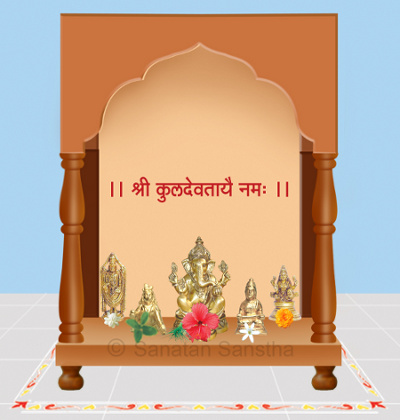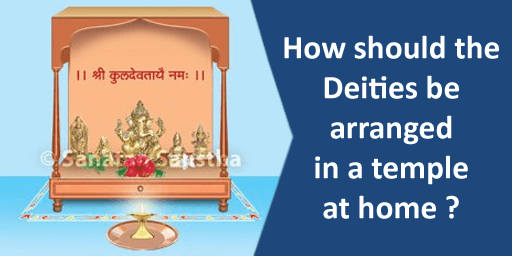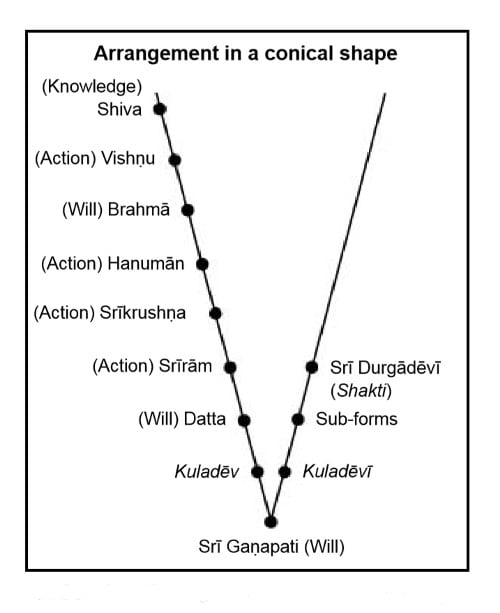Contents
- 1. What should be the direction of the temple at home?
- 2. What should be the features of the temple at home ?
- 3. How should the Deities be arranged in a temple at home ?
- 4. How should arrangement of Deities be if there are only sub-forms of Deities and no pictures or idols of superior Deities?
- 5. If in the temple at home there are many Deities, for example, if there are two or more sub-forms of a Deity, should both be retained or only one will do ?
- 6. If someone has been worshipping Shri Ganesh for long, is there a need to keep basic and sub-forms of other Deities separately and if yes which ones ?
- 7. How should the arrangement of Deities be if the Deities are depicted along with the Shakti ?
- 8. Where should strips containing photos or Names of several Deities be placed ?
- 9. If a devotee is blessed by a Guru, how should the temple at home be arranged?
- 10. What metal should the implements used in puja be made of ?
- 11. Why should we use old implements in puja ?
- 12. In puja, why is it important to blow a conch ?
Scientific importance and arrangement
1. What should be the direction of the temple at home?
Most seekers who follow Bhaktiyoga (Path of devotion) for God-realization begin their journey by worshipping a Deity. A temple at home is the basic requirement for puja (Ritualistic worship). Nowadays, the temple at home is designed as per convenience or as a showpiece without giving thought to its scientific aspect. In Spirituality, there are certain scientific aspects underlying every act performed in a specific way. In fact, only when each ritual is performed in the specified way, can one derive maximum spiritual benefits from it. It is with this objective that the direction in which the temple at home should be placed, its colour, shape, aesthetics and arrangement of Deity in it should be according to Spirituality. When we perform puja with bhav (Spiritual emotion), we benefit from the Deity Principle.
1 A. Reason for temple at home to be placed in east-west direction
The temple at home should always be in the east-west direction. When the temple faces the east, the waves emitted by the Deity get activated on the strength of kriyashakti (Energy of action) accumulated in the hollow in the east. This helps the nirgun (Non-materialised) waves of the Deity transform into sagun (Materialised) waves. When the kriya-shakti from the universe associated with the east-west direction manifests due to the waves emitted by the Deity, its direction is mostly upwards. The effect of the upward mobile waves on the environment lasts much longer than that of the downward mobile waves. Hence, for the effect of the sattvik (Sattva-predominant) waves emitted by the Deity to last longer, the direction of the temple at home should be east-west.
On the other hand, when ichha-shakti (Energy of will) accumulated in the north-south direction gets activated, it flows downwards. This flow activates the Raja-Tama-predominant waves causing distress waves in the environment. This causes obstruction to the sattvikta (Purity) emitting from the Deity and as a result the benefit obtained by the individual when compared with the first arrangement is less.

Temple at home
2. What should be the features of the temple at home ?
2 A. What material should the temple at home be made of ?
As far as possible, the temple at home should be made of sandalwood or teakwood. Sandalwood is expensive and may not be viable for the average individual. Comparatively, teakwood is cheaper and has better ability to retain and emit sattvik (Sattva-predominant) waves. Eventually it is the bhav towards God that attracts the Divine waves to the top of the temple, which are further dispersed in the house as per the requirement.
2 B. What should be the colour of the temple at home ?
Though the modern trend is to paint the temple at home with different colours in the name of decoration, it is ideal to retain the original colour of wood, that is, pale brown. Since a simple religious act like worship of a Deity amounts to spiritual practice, it helps the individual in traversing from the state of sagun to nirgun, meaning, from duality to non-duality.
The temple at home is made with the intention that the worshipper gets maximum Chaitanya from the worship of the Deities.
The level of bhakti and bhav in individuals with spiritual level above 50% is high and hence, the amount of Chaitanya generated as a result of their worship of the Deity is also high.
Above the spiritual level of 60%, the progress of the seeker is towards introversion. Idol worship, representative of the sagun form of bhakti in a way, makes the seeker extrovert. Hence, a seeker who finds solace in being an introvert, is lesser inclined to make a temple at home. (It is acceptable to have a temple at home if it is the wish of other family members.)
3. How should the Deities be arranged in a temple at home ?

3 A. Conical arrangement 
‘Arrange the Deities in a conical shape. In front of the devotee performing the puja at the tip of the cone, that is, at the centre, place Shri Ganesh. To the right of the devotee place the female Deities beginning with the family Deity, followed by sub-forms of superior Deities and then other female Deities. To the left of the devotee place the male Deities in the same sequence. Shri Ganesh, Kuladevi and Kuladev are sufficient, because this helps the individual awaken bhav faster than for other Deities. Our sojourn should be from Idol worship to the various sagun and nirgun Principles of the respective Deities, and from there on to God who, although completely linked with the nirgun, encompasses all these Principles.’
Images created by Sanatan are sattvik and as a result, they help evoke bhav. (Sattvik images of Deities created by Sanatan are available in different sizes. Click here to see !)
In Spirituality, there are certain scientific aspects underlying every act performed in a specific way. In fact, only when each ritual is performed in the specified way, can one derive maximum spiritual benefits from it. The following points provides answers to some of the frequently asked questions around various acts during ritualistic worship.
4. How should arrangement of Deities be if there are only sub-forms of Deities and no pictures or idols of superior Deities?
There is no need to place new photos of superior Deities in such case. Place the one’s you have as per the conical arrangement. Shri Ganesh, Kuladevi (Family female Deity) and Kuladev (Family male Deity) are sufficient, because this helps the individual awaken bhav (Spiritual emotion) faster than for other Deities. This rule is applicable to puja and it is associated to a large extent with the sagun (Materialised) form of Deities. In spiritual practice involving worship of sagun form, going from many to one, that is, going towards non-duality is more important. Our sojourn should be from Idol worship to the various sagun and nirgun (Non-materialised) Principles of the respective Deities, and from there on to God who, although completely linked with the nirgun, encompasses all these Principles.
5. If in the temple at home there are many Deities, for example, if there are two or more sub-forms of a Deity, should both be retained or only one will do ?
The inclination of the individual should be towards retaining only one of the two forms. Constant awareness of the fact that we have to move from ‘many to one’ at every step and developing faith in God to match this awareness should be our goal. Only then, can an individual traverse from sagun form to the nirgun form of God.
6. If someone has been worshipping Shri Ganesh for long, is there a need to keep basic and sub-forms of other Deities separately and if yes which ones ?
No. If someone has more faith in Shri Ganesh, retain only His photo / Idol. However, instead of getting confined to the Principle of a particular Deity, we should try to advance towards the nirgun God.
7. How should the arrangement of Deities be if the Deities are depicted along with the Shakti ?
At times, God is depicted along with the Shakti, for example, Sitaram, Lakshminarayan. In these photos when the Shakti (meaning Goddess here) is to the left of God and along with Her God, She is seen blessing devotees. In human anatomy, the Moon channel lies towards the left side and is soothing and Anand (Bliss)-bestowing. This is the tarak (Saviour) form of Shakti. In such depictions, God is considered as the chief Deity and His photo / Idol is placed to the right of Shri Ganesh. In some other photos / Idols, the female Deity is depicted to the right of the male Deity. The Sun channel lies on the right side and is bright and energy-bestowing. This is the marak (Destroyer) form of Shakti. When in a photo / Idol the Shakti is shown to the right of God, She is considered as the chief Deity because of Her being active, and Her photo / Idol is placed to the left of Shri Ganesh.
8. Where should strips containing photos or Names of several Deities be placed ?
The strips containing photos of several Deities help a seeker select the Deity of worship anywhere as per his need at a specific point in time. Besides, these photos created by Sanatan are more sattvik (Sattva-predominant) than Idols or photos created by anyone else, and as a result, they help evoke bhav faster. Further, it helps in achieving better concentration when viewing a Deity’s immaculately attired and bejeweled image. Such a strip may be pasted on the rear portion of the temple at home, where attention is drawn easily. According to his constitution, each one can focus on the Idol or combined image of Deities. If the temple at home is at a height, the strip of Deities can be pasted in the same or another room at a suitable height. It is important to ensure that this strip is not pasted where the divinity in it is likely to be disrespected. The rule mentioned here also applies to a strip with Names of several Deities.
9. If a devotee is blessed by a Guru, how should the temple at home be arranged?
Those who are already blessed with a Guru and live alone should place only the Guru’s photograph in the temple at home. As per the quote ‘गुरुब्र्रह्मा गुरुर्विष्णुर्गुरुर्देवो महेश्वरः ।’, for the disciple the Guru is everything. In such cases act accordingly.
If there are several family members residing in the same house and have faith in other Deities, then the following will be appropriate. If the Guru is a male, then His photo should be next to Shri Ganesh to His right, and should be followed by that of the family Deity and other Deities as specified earlier. If the Guru is a female, then Her photo should be placed adjacent to Shri Ganesh to His left, followed by a photo / Idol of the family female Deity and then other Female Deities as specified earlier.
10. What metal should the implements used in puja be made of ?
Nowadays, many people use stainless steel implements during puja (Ritualistic worship). Stainless steel has the least capacity to absorb the sattvikta (Purity) and the possibility of distressing energy getting attracted to it is high. We get neither the sattvikta nor Chaitanya (Divine consciousness) from them, nor do they awaken our bhav. They hardly provide any spiritual benefit.
A. Copper & brass have better capacity to absorb sattvikta
In the earlier times, implements used in worship of Deities were made of copper and brass. Every particle of these two metals has high capacity to absorb the sattvikta. Besides, cleaning these implements everyday with tamarind and lime before puja removes the distressing energy enveloping them.
B. Special features of copper
Copper has the capacity to absorb upto 30% the Principle of all Deities.
Copper has the capacity to absorb the sattvikta to the extent of 30%. Hence, it is considered auspicious.
Copper has the capacity to destroy the Raja-Tama components to the extent of 70%. Hence, keeping a substance (for example, water) in a copper vessel reduces the Raja-Tama components in water by 70% and the sattvikta in it also begins to increases.
11. Why should we use old implements in puja ?
Old implements become sattvik. Repeated use of same implements benefit the worshipper. Use of such implements that are charged with sattvikta help ‘awaken’ an Idol or an image of a Deity faster.
A. Implements used in puja for several years become sattvik
Use of new implements in puja does not give much spiritual benefit, because their getting activated and developing the power to absorb sattvikta takes several years of use in puja or Arati. Only the immense bhav of the worshipper can bring about the required level of sattvikta within a few months of use. Bhav in most devotees is less; hence, they should perform puja or Arati with old implements.
B. Proximity to the Deity’s Idol
Since these implements are always placed in front of the Deity, they can absorb Chaitanya and sattvikta emitted by the Deity in larger quantities.
12. In puja, why is it important to blow a conch ?
The sound energy generated by blowing a conch activates the subtler waves in the universe that descend from above, and in a short time cause disintegration of Raja-Tama particles in the atmosphere. Blowing a conch in a house makes the atmosphere within pure and Holy; so also the atmosphere surrounding the individual becomes sattvik to facilitate his spiritual practice. The individual is able to absorb better sattvik waves coming from the Deity.


I would be part of this holy Sanathan sanstha
Namaskar Shri. Sanjay Gupta ji,
Thank you for contacting us. We are glad to know that you want to join us in this spiritual cause. We request you to fill your details at http://www.Sanatan.org/sampark so that seekers can contact you regarding this.